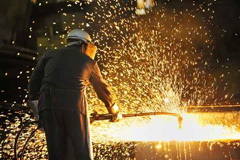
| A major manufacturing company has come up with a new application for BAPI’s VOC sensor. They’re literally using it to help clear the air at their main fabricating plant.
BAPI designed the VOC sensor as an alternative to CO2 sensors for demand-controlled ventilation, but a growing number of facilities with specific substance concerns are finding that it is a good solution for them as well. In this case, the offending substances were the byproducts of welding. Greenheck Fan Corporation is the industry-leader in the manufacture of HVAC air movement and control equipment. Greenheck contacted BAPI last year while looking for a cost-effect way to improve air quality at their main welding facility in Schofield, Wisconsin. Specifically, they were looking for a way to control exhaust fans and bring in conditioned outside air only when necessary. The goal was to maintain good air quality and as a bonus, save energy. BAPI’s suggestion to use the VOC sensor turned out to be a great success. “There was a haze in the air at the plant,” Greenheck Manufacturing Engineer Brent Mattson explained. “We had complaints from staff about the haze even though the air quality was within OSHA specified levels.” Greenheck took the complaints seriously; especially considering recent findings that overexposure to two components in welding fumes, manganese and hexavalent chromium, can cause brain damage or lung cancer. The 138,000 square foot facility has 30 welding bays, each with a source capture hood venting air to the outside. There are also five rooftop exhaust fans and three makeup air units supplying conditioned air. Running all the vents together all day was expensive and overkill, but they had no way to accurately sense when ventilation should be increased or decreased – that is until they tried the VOC sensor. VOCs are chemicals that contain carbon and can be emitted as gases at room temperature. They evaporate from cleaners, adhesives, paints, carpet, furniture and many other sources. The BAPI unit is a total VOC sensor, meaning it reacts to all of the 5,000 to 10,000 unique VOCs and provides an output that represents the combined level of all of them. Although it was unclear exactly which welding by-products were affecting the sensor, Greenheck testing showed that the output of the VOC sensor rose and fell in relation to the welding activity and haze, giving them the method they needed control the ventilation. The Greenheck team then designed a custom system for the plant. Now the hoods, fans and makeup air units are all communicating with each other and with the six BAPI VOC sensors located throughout the building. “We’re saving money,” said Mattson. “And we compared the results of the air sampling with the new system to the OSHA standard and we’re well below the standard.” The utility costs at the facility have dropped from 3.5% of the total cost to under 3% since installing the system, and Greenheck expects to recoup the cost of the project in about 1.8 years. They also received a $12,000 grant from Focus on Energy to help offset the $40,000 cost of the project. According to Mattson, the savings is nice, but keeping the staff healthy and happy is the most important part. “There is no longer any haze and no longer any complaints about the air quality,” he said. Applications Growing for Versatile SensorThe VOC sensor used at the welding plant was originally designed by BAPI as a direct replacement for a CO2 sensor in demand-controlled ventilation. It detects human-generated VOCs as they build up in a room, indicating when more ventilation is needed, just like a CO2 sensor does. But it also detects contaminants from other sources such as building materials, cleaners, perfumes, furniture, equipment and carpet off-gassing. These are the types of contaminants that can adversely affect human health and productivity and yet they are invisible to a CO2 sensor. Although it was designed as a replacement for a CO2 sensor, a growing number of facilities with specific substance concerns — such as the welding plant — are finding that the VOC sensor is the solution. Besides the welding plant, the sensor has proven effective in indoor swimming pools, cadaver labs, and gyms and exercise centers. It has even been used to tell when the outside air has high levels of automobile exhaust or forest fire smoke. The list of possibilities for this unique sensor is nearly endless. by Terry Noble, |
|




